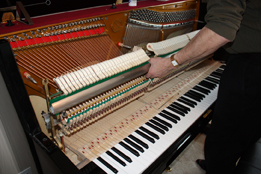Lesson 2
1. Lesson 2
1.12. Lesson 2 Summary
Module 4: Quadratic Equations and Inequalities
Lesson 2 Summary

In this lesson you investigated the following questions:
- How can previous patterns of factoring be extended to polynomial expressions?
- How does the zero-product property relate to solving quadratic equations by factoring?
In the real world you may take apart an object or reduce the object to its component parts in order to troubleshoot problems. An engine can be rebuilt in this way. The beautiful sound of a piano may be restored after a professional piano tuner has taken the piano apart to repair the out-of-tune parts. A clogged sink drain may need to be taken apart in order to clear the clogged portion.
In mathematics, factoring is a way in which polynomials can be reduced to parts. In this lesson you reviewed factoring strategies that you learned in a previous math course. You extended those patterns to the factoring of polynomial expressions by looking for common structures between quadratic and polynomial expressions.
You investigated the zero-product property, which states that if the product of two or more factors is equal to zero, at least one of the factors is equal to zero. The method of solving quadratic equations by factoring the equations and then setting each factor to zero is based on the zero-product property.
You applied the zero-product property to the solution of quadratic equations. By setting a quadratic equation to zero and factoring the quadratic expression, you expressed the equation as a product of factors. Since the equation is equal to zero when either or both of the factors are equal to zero, the roots can be determined by setting each factor to zero.
In the next lesson you will learn another algebraic method for solving quadratic equations. This method will eventually lead to a formula that you can use to solve any quadratic equation algebraically!